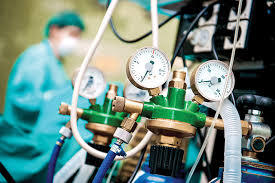Medical Gas Pipeline Systems (MGPS)
Datacon provides expert Medical Gas Pipeline System (MGPS) solutions, ensuring the safe and efficient delivery of medical gases throughout healthcare facilities. Our MGPS service includes the design, installation, and maintenance of secure, reliable systems for gases like oxygen, nitrogen, and nitrous oxide, tailored to meet the specific needs of hospitals and clinics.

Benefits of MGPS (Medical Gas Pipeline System) by Datacon:-
- a) Uninterrupted Gas Supply: Ensure a continuous, reliable supply of essential medical gases like oxygen, nitrogen, and nitrous oxide, eliminating the need for cumbersome portable cylinders.
- b) Enhanced Patient Safety: Our state-of-the-art safety features, including pressure regulators, alarms, and shut-off valves, guarantee safe, error-free gas delivery for critical patient care.
- c) Increased Efficiency: Streamline hospital operations with an integrated system that reduces downtime, minimizes gas wastage, and improves workflow.
- d) Cost Savings: Say goodbye to frequent gas cylinder replacements and reduce operational costs with a centralized, cost-efficient MGPS that cuts down on gas usage and storage needs.
- e) Compliance & Reliability: Datacon’s MGPS systems are built to meet global standards, ensuring your facility remains fully compliant with industry regulations while maintaining the highest levels of reliability.
- f) Easy Maintenance & Support: With our comprehensive maintenance and support services, you can rest easy knowing that your system will stay in optimal condition, with quick troubleshooting and timely repairs.
How it works:-
1. Gas Sources
- Central Gas Supply: Medical gases (e.g., oxygen, nitrogen) are stored in large cylinders or tanks at a central location, such as an oxygen generation plant or bulk liquid storage system.
- Backup Systems: Backup sources like cylinder banks ensure a continuous supply in case of a failure in the central supply.
2. Distribution System
- Pipeline Network: A network of pipes distributes medical gases throughout the hospital or healthcare facility.
- Pipes & Fittings: Piping is typically made of copper or stainless steel to ensure gas purity and prevent contamination. The pipes are color-coded for easy identification (e.g., green for oxygen, white for nitrous oxide).
- Pressure Regulators: These are installed along the pipeline to control and maintain a consistent gas pressure throughout the system.
3. Valves and Control
- Main Isolation Valve: Located near the source of the gas, it allows the system to be shut off or isolated in case of maintenance.
- Zone Valves: These valves control gas supply to different parts or zones of the facility.
- Point-of-Use Valves: Located at the patient’s bedside or in operating rooms to connect the gas pipeline to equipment such as ventilators.
4. Safety Features
- Alarms & Monitoring Systems: Sensors monitor gas pressure, flow, and leaks, and alarms alert staff if there’s an issue.
- Non-return Valves: Prevent contamination of the gas supply by ensuring no backflow from patient equipment into the pipeline.
- Purity & Filtration: Medical gas supply must meet stringent purity standards, and filtration units may be installed to ensure gas cleanliness.
5. Point-of-Use
- Outlet Terminals: Gas supply is provided at patient care areas (e.g., hospital rooms, operating theaters) via wall outlets or terminal units.
- Medical Equipment Connections: Outlets are connected to devices such as oxygen concentrators, anesthesia machines, and ventilators.
6. Maintenance and Compliance
- Routine Inspection: Regular checks and maintenance are required to ensure system integrity and functionality.
- Standards Compliance: The system must meet regulatory standards, such as those set by the National Fire Protection Association (NFPA), and local health authorities to ensure safety.
7. Emergency and Backup
- Emergency Backup: In case of a power failure or central gas source issue, backup cylinders or backup generators are employed to maintain gas supply.
- Oxygen Cylinder Bank: A bank of cylinders is available to supply gas when needed, typically during emergencies or maintenance downtime.

Empower your healthcare facility with Datacon’s MGPS and provide the best care with confidence, safety, and efficiency.

